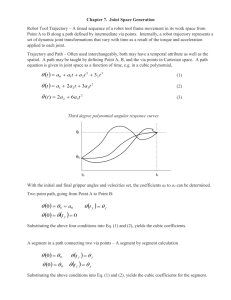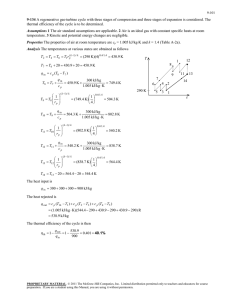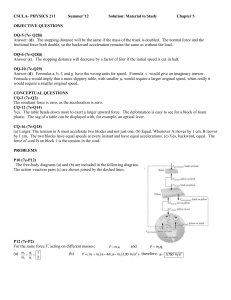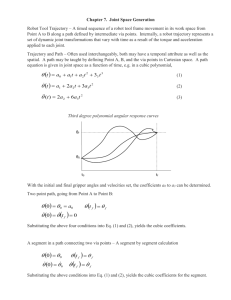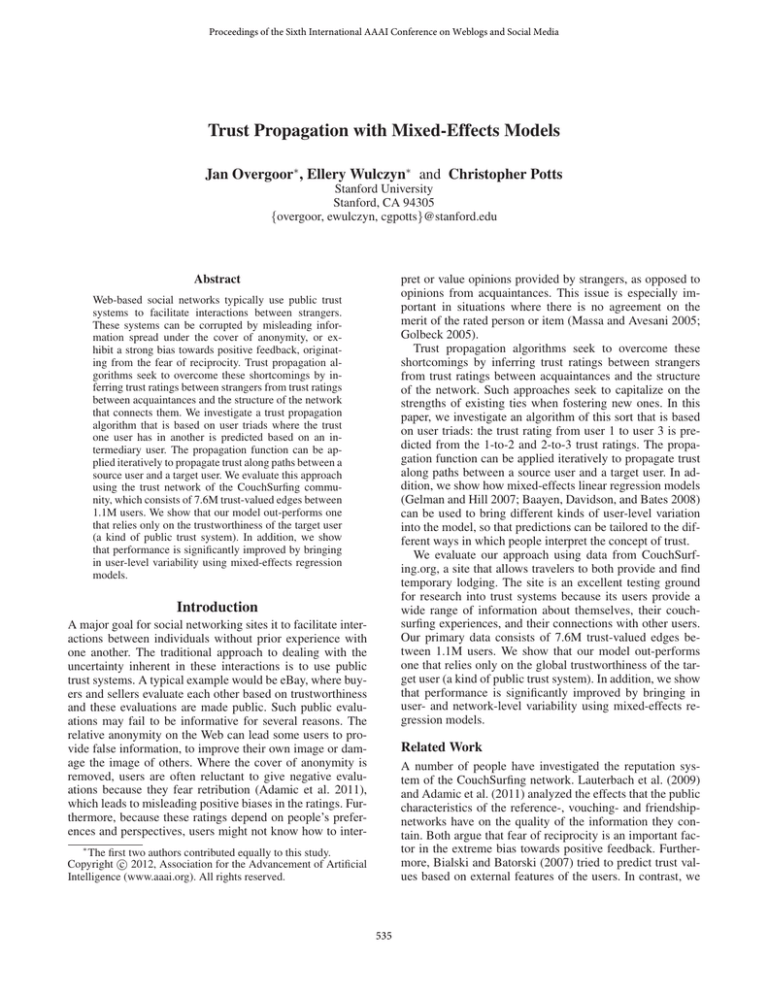
Proceedings of the Sixth International AAAI Conference on Weblogs and Social Media
Trust Propagation with Mixed-Effects Models
Jan Overgoor∗ , Ellery Wulczyn∗ and Christopher Potts
Stanford University
Stanford, CA 94305
{overgoor, ewulczyn, cgpotts}@stanford.edu
Abstract
pret or value opinions provided by strangers, as opposed to
opinions from acquaintances. This issue is especially important in situations where there is no agreement on the
merit of the rated person or item (Massa and Avesani 2005;
Golbeck 2005).
Trust propagation algorithms seek to overcome these
shortcomings by inferring trust ratings between strangers
from trust ratings between acquaintances and the structure
of the network. Such approaches seek to capitalize on the
strengths of existing ties when fostering new ones. In this
paper, we investigate an algorithm of this sort that is based
on user triads: the trust rating from user 1 to user 3 is predicted from the 1-to-2 and 2-to-3 trust ratings. The propagation function can be applied iteratively to propagate trust
along paths between a source user and a target user. In addition, we show how mixed-effects linear regression models
(Gelman and Hill 2007; Baayen, Davidson, and Bates 2008)
can be used to bring different kinds of user-level variation
into the model, so that predictions can be tailored to the different ways in which people interpret the concept of trust.
We evaluate our approach using data from CouchSurfing.org, a site that allows travelers to both provide and find
temporary lodging. The site is an excellent testing ground
for research into trust systems because its users provide a
wide range of information about themselves, their couchsurfing experiences, and their connections with other users.
Our primary data consists of 7.6M trust-valued edges between 1.1M users. We show that our model out-performs
one that relies only on the global trustworthiness of the target user (a kind of public trust system). In addition, we show
that performance is significantly improved by bringing in
user- and network-level variability using mixed-effects regression models.
Web-based social networks typically use public trust
systems to facilitate interactions between strangers.
These systems can be corrupted by misleading information spread under the cover of anonymity, or exhibit a strong bias towards positive feedback, originating from the fear of reciprocity. Trust propagation algorithms seek to overcome these shortcomings by inferring trust ratings between strangers from trust ratings
between acquaintances and the structure of the network
that connects them. We investigate a trust propagation
algorithm that is based on user triads where the trust
one user has in another is predicted based on an intermediary user. The propagation function can be applied iteratively to propagate trust along paths between a
source user and a target user. We evaluate this approach
using the trust network of the CouchSurfing community, which consists of 7.6M trust-valued edges between
1.1M users. We show that our model out-performs one
that relies only on the trustworthiness of the target user
(a kind of public trust system). In addition, we show
that performance is significantly improved by bringing
in user-level variability using mixed-effects regression
models.
Introduction
A major goal for social networking sites it to facilitate interactions between individuals without prior experience with
one another. The traditional approach to dealing with the
uncertainty inherent in these interactions is to use public
trust systems. A typical example would be eBay, where buyers and sellers evaluate each other based on trustworthiness
and these evaluations are made public. Such public evaluations may fail to be informative for several reasons. The
relative anonymity on the Web can lead some users to provide false information, to improve their own image or damage the image of others. Where the cover of anonymity is
removed, users are often reluctant to give negative evaluations because they fear retribution (Adamic et al. 2011),
which leads to misleading positive biases in the ratings. Furthermore, because these ratings depend on people’s preferences and perspectives, users might not know how to inter-
Related Work
A number of people have investigated the reputation system of the CouchSurfing network. Lauterbach et al. (2009)
and Adamic et al. (2011) analyzed the effects that the public
characteristics of the reference-, vouching- and friendshipnetworks have on the quality of the information they contain. Both argue that fear of reciprocity is an important factor in the extreme bias towards positive feedback. Furthermore, Bialski and Batorski (2007) tried to predict trust values based on external features of the users. In contrast, we
∗
The first two authors contributed equally to this study.
c 2012, Association for the Advancement of Artificial
Copyright Intelligence (www.aaai.org). All rights reserved.
535
The goal of CS is to facilitate new connections between
people, with its reputation system as a central component. It
allows people to evaluate whether or not they want to interact with someone they have never met before. It highlights active and respectable users and reveals misbehavior.
Since the interactions primarily take place offline, preventing bad ones is important. The public reference system is,
however, not a fully reliable representation of the sentiment
between users. For example, only 1.6% of references are
non-positive, which suggests more positivity than is warranted (Adamic et al. 2011). Not everyone leaves a reference
after an experience, and, if they do, they may be strongly biased towards a positive one out of a fear of retribution. The
confidential trust values that users assign to each other are
far less correlated (p = 0.382) than the public friendship
levels (p = 0.705). This strongly suggests that the public
rating features of the site are shaped in large part by fears of
reciprocity.
The complete social network consists of 3.4M users, 1.1M
of which have given or received at least one trust rating. In
total, there are 7.6M connections with a trust rating (µ =
4.26, σ 2 = 1.19).
use only the network structure to predict trust values.
The task of predicting trust values from a trust network
has been studied before. Guha et al. (2004) formulate a
framework for propagating trust and distrust using matrix
multiplication methods to predict the sign of a link in the
Epinions network, and they discuss the issue of mapping
predicted real values back to the relevant trust categories.
Leskovec, Huttenlocher, and Kleinberg (2010) applied logistic regression, without propagation to predict the sign of
a link in Epinions, Wikipedia, and Slashdot reputation systems using user features such as average incoming trust and
frequencies of different types of user triads.
Due to the existence of users where there is no agreement
on their trustworthiness in the Epinions network, Massa and
Avesani (2005) argues for a local trust metric, personalized
to each user as opposed to global trust systems. We propose
a new algorithm for computing a local trust metric via trust
propagation in a network with six trust categories instead of
only two, and we explicitly model user differences.
CouchSurfing Dataset
CouchSurfing (CS; http://www.couchsurfing.org/) is an international hospitality network that allows travelers to find temporary hosts on their journeys. Travelers (“surfers”) request
hospitality from hosts who advertise their homes on the site.
Due to the high-stakes of both letting a stranger into one’s
home and staying at a stranger’s house, users are invested
in a well-functioning trust system and take trust ratings seriously. As a result, data from the CS community is especially
valuable for investigations into online trust. Users of the site
maintain a public profile that contains personal information
and a history of references. After a hospitality exchange,
users leave each other public textual references, which are
tagged as positive, neutral, or negative.
Furthermore, when users make an online friendship connection, they quantify their relationship along the dimensions of friendship degree and trust degree. The friendship
degrees are visible to everyone on the site, but trust values
are hidden. This allows users to confidentially assess each
other’s trustworthiness. A legend of the trust degrees (“Site
Val.”), as they appear on the site, is displayed in Table 1.
Note that the semantics for a trust value of 1 are closer to an
unknown value than a very low score. In order to work with
these values more effectively, and stay truer to their semantics, we mapped the occurrences of 1 to that of the mean of
all trust values in the data set (4.26). The actual values we
used are displayed in the Used Val. column of Table 1.
Site
Val.
1
2
3
4
5
6
Descriptor
I don’t know them enough to decide
I don’t trust this person
I trust this person somewhat
I generally trust this person
I highly trust this person
I would trust this person with my life
Freq.
455K
21K
934K
2791K
2497K
912K
Task
Our general task is to predict the trust one user has in another. In our approach, we base this estimation on the paths
that connect them. We primarily investigate how trust propagates between people who are two steps apart. This can be
thought of as closing a trust triad (see t̂13 in Figure 1). We
define a trust propagation function between users 1 and 3
using the path via user 2 as
t̂13 = τ (t12 , t23 )
where tij is the trust user i has in user j. Since there may be
several paths of length two between two users (with set K
of intermediate users), we can extend the model by letting
t̂13 = g({τ (t1k , tk3 )|k ∈ K})
where g aggregates all the different predictions associated
with the different length two paths. Given such a one-step
trust propagation function, one can predict trust on paths of
length n by applying the function n − 1 times, for example:
t̂14 = τ (τ (t12 , t23 ), t34 ) = τ (t̂13 t34 )
This too is illustrated in Figure 1. In this paper, our focus is
on paths of lengths 2 and 3. We plan to investigate performance on paths of longer length in future work.
Trust Propagation Models
Used
Val.
The global model predicts the trust user 1 has in user 3 to
be the average of the trust scores user 3 has received. This is
designed to approximate a public trust system, where people
look at a set of public reviews and make their own assessment based on weighing the positive and negative opinions.
The global model is independent of the trust triads between
user 1 and user 2. In fact, it is independent of user 1, since all
users will be assigned the same trust in user 3. Although this
model cannot take into account differences in how much one
4.26
2
3
4
5
6
Table 1: Legend and frequency of trust values.
536
Model
Triad
MSE (δ)
All-Triad u1–u3
MSE (δ)
mean
global
lin
sp-avg
lmer
0.7498 (+0.027)
0.7079 (+0.265)
0.6501 (+0.109)
0.6427 (+0.116)
0.5327 (+0.226)
0.6079 (+0.145)
0.5988 (+0.154)
0.5167 (+0.238)
Table 2: Performance on the two-step propagation prediction
task. δ is the difference in MSE between applying the model
to a shuffled versus a non-shuffled network.
Figure 1: Trust propagation.
Experiments
To test the merit of the different models, we extracted 14.4M
triads and 180M tetrads from the CS trust network. For the
mixed-effects model lmer, we used the lme4 package in R
(Bates 2005). Model performance is measured in MSE between the predicted value and the actual value. Each model
was tested using 5-fold cross-validation, where we train on a
random set of 300K training examples and tested on disjoint
random set of 5K test examples for each fold.
We test our models on simple triad closure (“Triad”) and
triad closure using the weighed average of all triad closures
between user 1 and user 3 (“All-Triads u1-u3”). Next we
test the models on their merit for propagation. Since there
is an error associated with our two-step trust propagation
functions, we expect repeated application of these functions
to lead to larger error terms. To evaluate our model of trust
propagation, we would ideally investigate how the error increases for every path length up to the maximum in the system. In this paper, we only examine paths of length three, by
applying the trust propagation function twice.
We evaluate our models against two baseline models. The
model mean always predicts the mean of all trust values in
the data set. We chose this as a baseline since 81.7% of
scores are within one standard deviation of the mean. As
a result, simply predicting the average trust in the system,
which is 4.26, has a low MSE. Furthermore, in order to disentangle the influence of the distribution of trust scores from
the structure of trust triads on model performance, we created a second data set by shuffling all the trust values and
then tested our models on this new data set (Golbeck 2005).
The comparison between a model’s performance on a shuffled versus a true data set indicates how well it captures the
structure of the trust network.
The results for two-step propagation are displayed in Table 2, and two-step propagation is displayed in Table 3. δ
denotes the improvement over the MSE of the model on the
shuffled data set.
user trusts another, it has one advantage: the set of users who
have reviewed user 3 is larger than the set of users that user 1
is acquainted with that have reviewed user 3, so there is typically more information available to global than a model that
uses triads to make predictions, though this information is of
lower quality because it is not specific to user 1.
In contrast to global, the models lin(t12 , t23 ),
sp-avg(t12 , t23 ), and lmer(t12 , t23 ) use triad structure
to make predictions and can assign different trust values to
a fixed user 3 for different values of user 1. lin(t12 , t23 ) is a
simple linear model of t13 using t12 , t23 , and the interaction
term t12 · t23 as covariates. sp-avg(t12 , t23 ) predicts the average value of t13 given t12 and t23 . In practice, this means
binning the cases by their values of t12 and t23 and taking
the average of the corresponding t13 values. If we consider
t12 , t23 , and t13 to be random variables, then under certain
probabilistic models for p(t13 | t12 , t23 ), sp-avg(t12 , t23 )
is equivalent to E[t3 | t1 , t2 ], which achieves the lowest
possible mean squared error (MSE) in predicting t13 given
only t12 and t23 . In other words, with MSE as a model
performance metric, sp-avg is better than any model that
uses only t12 and t23 to predict t13 , including lin.
Given the same values of t12 and t23 , lin and sp-avg will
predict the same trust for any user 1 and a fixed user 3. If
there are differences between users in how trust propagates
along a path with the same trust structure, it may be possible
to make better predictions by devising models that take these
differences into account. We therefore extend the simple linear fixed effects model lin to create a linear mixed effects
model with user 1 as a random effect (lmer). This means
that the degree to which t13 will be affected by t12 , t23 , and
the intercept term will depend on user 1. In general, linear
mixed effect models are appropriate for representing clustered, and therefore dependent, data. This arises, for example, when data is gathered over time on the same individuals,
which is the case for the CS trust network.
Discussion
In the simple triad closure setting, all models perform better
than our baselines. This indicates that the models discover
some structure in the data despite the fact that the distribution of scores is so heavily clustered around the mean. The
models that are some function of t12 and t23 all outperform
the models that are not (i.e., mean and global). This demon-
We aggregate different predictions for the trust user 1
has in user 3 by letting the aggregation function g be the
weighted average of the predictions, where the weights correspond the trust user 1 has in the intermediary user 2. This
is motivated by the consideration that information coming
from trusted friends is more reliable.
537
Model
mean
global
lin
sp-avg
lmer
achieved by bringing into the models the substantial amount
of variability users display in their use of these rating systems as well as differences in how trusting they are.
We plan to build on these insights by exploring how accurately our method of trust propagation can estimate trust
beyond three steps. It will also be interesting to investigate
the effect that user features like sex, age and origin have
on propagation. One potential application of inferred trust
scores is to provide personalized trust assessments between
users in web-based social networks. Another is to investigate
how an approximation of trust that a user has in a source can
be used to weigh the information from that source when aggregating information from many sources.
MSE (δ)
0.7595 (+0.000)
0.8322 (+0.000)
0.8144 (−0.148)
0.7887 (−0.122)
0.5392 (+0.126)
Table 3: Performance on the three-step propagation prediction task. δ is the difference in MSE between applying the
model to a shuffled versus a non-shuffled network.
strates that there is structure in the trust triads that can be
used to improve predictive power over a global metric.
The model lin performs slightly worse than sp-avg, which
is to be expected since it is a less flexible model. lin’s fitted
coefficients are nonetheless informative:
Acknowledgments
We thank George Zisiadis from CouchSurfing and Bogdan
State for their assistance in providing the data and making
the project possible. This research was supported in part by
ONR grant No. N00014-10-1-0109.
t13 = 2.72 + 0.2t12 − 0.04t23 + 0.04t12 t23
The effect of coefficient for t12 is an order of magnitude
higher than the coefficient for t23 . This might seem surprising since we are predicting the trust user 1 has in user 3
and t23 is the only information we have about user 3. Instead, what weighs most heavily into the prediction is how
much user 1 trusts user 2, an indicator of user 1’s trust behavior. It may be that how much a user trusts a stranger does
not depend as much on the trustworthiness of the stranger,
as judged by other people, as on that user’s trust behavior.
This underlines the subjectivity of trust and further motivates modeling user differences in trust behavior.
The strong performance of lmer shows that there are differences between users in trust behavior and in how trust
propagates along a path with the same trust-valued edges.
Modeling these differences improves accuracy. Finally, we
observe using the average prediction over all trust triads between the source and target users leads to greater accuracy
(except for global and mean, whose predictions are independent of the the trust triads).
For the task of propagating trust along three-step paths,
most models perform worse than when predicting trust over
two-step paths. We find, however, that lmer performs approximately the same on three-step paths as over two-step
paths. This indicates that a model that uses trust triad structure and user differences is able to propagate trust well. As
mentioned above, we would want to test the performance of
lmer on paths of length larger than 3 in future work.
References
Adamic, L.; Lauterbach, D.; Teng, C.; and Ackerman, M.
2011. Rating friends without making enemies. In Fifth International AAAI Conference on Weblogs and Social Media.
Baayen, R.; Davidson, D.; and Bates, D. 2008. Mixedeffects modeling with crossed random effects for subjects
and items. Journal of Memory and Language 59(4):390–
412.
Bates, D. M. 2005. Fitting linear mixed models in R. R
News 5(1):27–30.
Bialski, P., and Batorski, D. 2007. Trust networks: Analyzing the structure and function of trust. In Sunbelt conference
poster.
Gelman, A., and Hill, J. 2007. Data Analysis Using Regression and Multilevel/Hierarchical Models. Cambridge
University Press.
Golbeck, J. 2005. Computing and applying trust in webbased social networks. Ph.D. Dissertation, University of
Maryland.
Guha, R.; Kumar, R.; Raghavan, P.; and Tomkins, A. 2004.
Propagation of trust and distrust. In Proceedings of the
13th international conference on World Wide Web, 403–412.
ACM.
Lauterbach, D.; Truong, H.; Shah, T.; and Adamic, L.
2009. Surfing a web of trust: Reputation and Reciprocity
on CouchSurfing. com. 2009 International Conference on
Computational Science and Engineering 346–353.
Leskovec, J.; Huttenlocher, D.; and Kleinberg, J. 2010. Predicting positive and negative links in online social networks.
Proceedings of the 19th international conference on World
wide web 641–650.
Massa, P., and Avesani, P. 2005. Controversial users demand
local trust metrics: An experimental study on epinions.com
community. In Proceedings of the National Conference on
Artificial Intelligence, volume 20, 121. Menlo Park, CA;
Cambridge, MA; London; AAAI Press; MIT Press; 1999.
Conclusion and Future Work
We investigated a trust propagation algorithm that uses trust
ratings between acquaintances to infer trust ratings between
strangers in a social network. We argued that such algorithms have advantages over the public trust systems in wide
use today. We then evaluated a family of trust propagation
algorithms using data from CouchSurfing.org, a large social
networking site with a wide range of trust ratings and other
social metadata. The results provide initial experimental evidence in favor of trust propagation. In addition, we showed
that using mixed-effects models with user-specific hierarchical effects can substantially improve performance. This is
538


